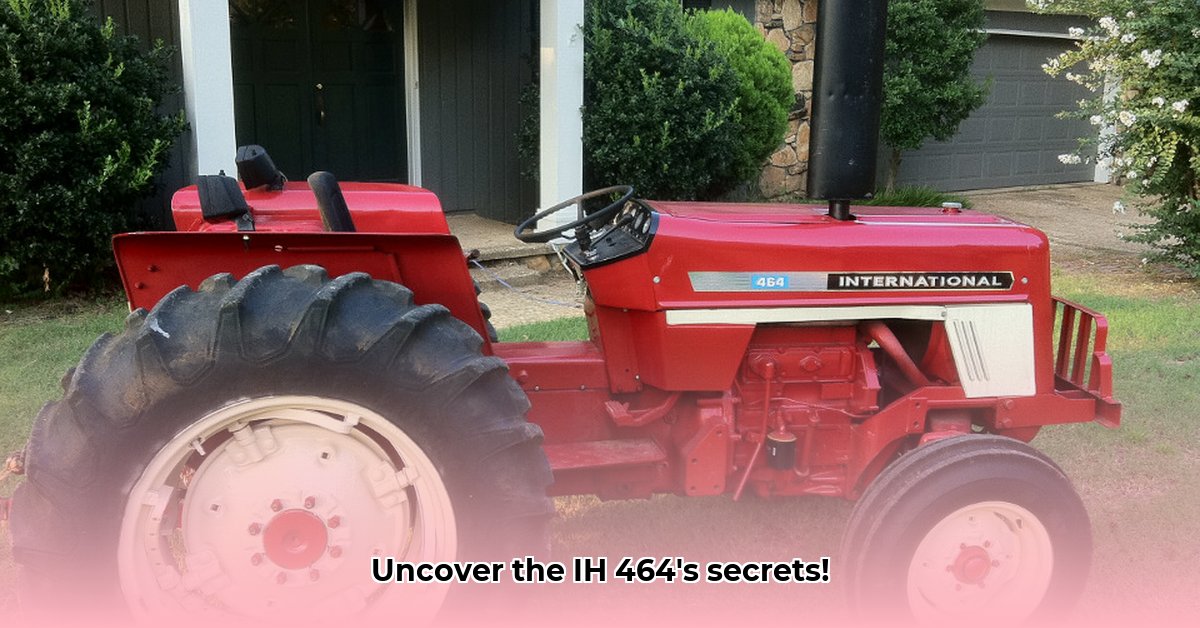
This comprehensive guide explores the International Harvester 464 tractor, examining its historical context, technical specifications, performance capabilities, and its place in the evolution of sustainable agricultural practices. We'll also delve into its value as a collector's item and the process of restoration. For additional vintage tractor information, check out this related resource.
International Harvester 464: A Workhorse of the 1970s
The International Harvester 464, manufactured between 1973 and 1978, was a ubiquitous sight in farm fields across North America. This dependable utility tractor, characterized by its robust build and straightforward design, played a vital role in mid-20th century agriculture. While lacking the advanced features of modern tractors, its simplicity and reliability made it a favorite among farmers. How did this unassuming machine stand the test of time, and what can we learn from its legacy?
Under the Hood: Technical Specifications
The IH 464 offered farmers a choice of powerplants: a gasoline engine (C-175) or a diesel engine (D-179). Both provided respectable power, ideal for the diverse tasks faced on typical farms of that era. The gasoline engine delivered 39 horsepower at the drawbar (for pulling implements) and 45 horsepower at the power take-off (PTO) shaft (for operating attached machinery). The diesel engine, while slightly less powerful (38 and 44 hp respectively), offered greater fuel efficiency compared to its gasoline counterpart. Both models shared the same smooth-shifting 8-speed synchromesh transmission, enabling efficient operation across varied terrains and tasks. The tractor's 70-liter (approximately 18.5-gallon) fuel tank provided sufficient capacity for extended work sessions.
| Feature | Gasoline (C-175) | Diesel (D-179) | Units | Notes |
|---|---|---|---|---|
| Drawbar HP | 39 | 38 | hp | Power for pulling implements |
| PTO HP | 45 | 44 | hp | Power for operating attached machinery |
| Transmission | 8-speed synchromesh | 8-speed synchromesh | Smooth gear changes | |
| Fuel Capacity | 70 | 70 | Liters | Approximately 18.5 gallons |
| Wheelbase | ~75 | ~75 | Inches | Distance between front and rear axles |
| Typical Tire Sizes | 6.00-16 (F), 13.6-28 (R) | 6.00-16 (F), 13.6-28 (R) | Could vary slightly depending on model | |
| Approximate Weight | 4100-5130 | 4100-5130 | lbs | Varied slightly based on configuration |
The 464's dimensions and weight were typical for utility tractors of its era, making it maneuverable yet capable of handling significant workloads. Interestingly, this relatively modest size and power are key to understanding its fuel economy – a topic we explore in more detail later. Considering its capabilities, wasn't it remarkably economical for its time, particularly compared to its modern counterparts?
On the Farm: Performance and Real-World Capabilities
The IH 464 was a versatile machine, designed to tackle a wide range of farm tasks. From plowing and cultivating to hauling and powering implements, it served as a reliable workhorse for countless farmers. While precise performance data from its operational era may be limited, anecdotal evidence paints a picture of a dependable and robust tractor capable of handling the demands of family farms. Its simple design also made maintenance and repairs relatively straightforward, reducing downtime and maintenance costs.
Historical Context and the Evolution of Sustainable Agriculture
The IH 464 represents a significant stage in agricultural technology. Compared to modern tractors, its technology was quite basic, lacking advanced electronics, GPS guidance, and sophisticated safety features. This simplicity, however, provides a valuable point of comparison when examining the advancements in sustainable agriculture. Modern tractors, with their enhanced fuel efficiency, reduced emissions, and precision technologies, mark a significant step forward in environmentally responsible farming. The 464's legacy thus serves as a benchmark illustrating the dramatic progress in sustainability within the agricultural sector. How effective were the fuel-saving measures in modern tractors compared to the simple yet reliable IH 464?
Comparing the 464 to Modern Tractors: A Look at Sustainable Practices
Modern tractors stand in stark contrast to the IH 464. Contemporary machines boast significantly more horsepower, enabling increased productivity and faster completion of tasks. Fuel efficiency has also improved dramatically, with modern tractors consuming far less fuel to achieve comparable output. Furthermore, the integration of advanced technologies, such as GPS guidance and precision spraying systems, contributes to sustainable farming practices by minimizing resource wastage and environmental impact. This overall leap in efficiency and sustainability presents a compelling argument for technological advancements in agriculture.
Collector's Value and Restoration
The IH 464 has transitioned from a workhorse to a collector's item, capturing the interest of enthusiasts fascinated by vintage agricultural machinery. Restoring one of these tractors requires dedication, mechanical skills and access to often-scarce parts. Online communities and specialized suppliers provide invaluable resources for enthusiasts embarking on this undertaking.
Restoring a 464: A Guide
- Assessment: A thorough inspection is crucial to gauge the extent of restoration needed.
- Parts Acquisition: Sourcing parts is often challenging. Online forums, specialized suppliers, and salvage yards represent valuable avenues.
- Restoration: Professional help or personal mechanical expertise is essential. Detailed guides and manuals are invaluable assets.
- Maintenance: Regular maintenance, including oil changes and lubrication, is key to maintaining the tractor’s value and operational capabilities.
Conclusion: Honoring the Past, Embracing the Future
The International Harvester 464 stands as a testament to the ingenuity and resilience of mid-20th-century agricultural technology. While its design may seem simplistic compared to modern counterparts, it laid the groundwork for the advancements in sustainable agriculture we see today. Its story underscores the continuous pursuit of efficient, environmentally responsible farming practices, making its legacy both historically significant and remarkably relevant to contemporary agricultural practices.